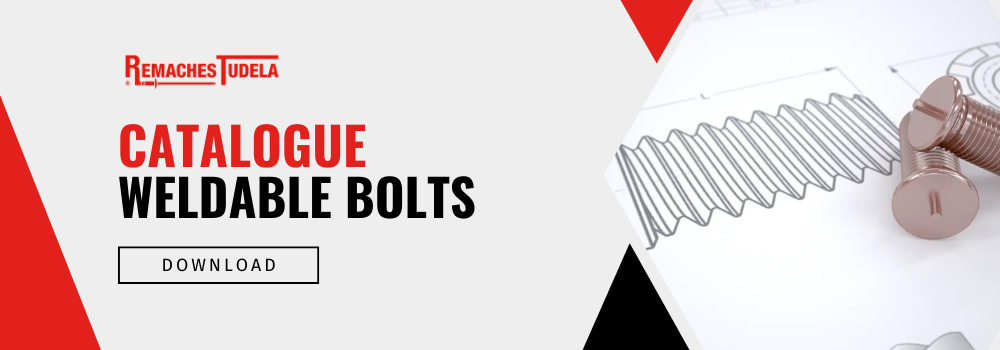Stud welding is a crucial technique in the fields of engineering and construction, serving as a fundamental process for efficiently and securely joining metal elements.
At Remaches Tudela, we are passionate about providing you with the best information on material fastening and joining techniques. In this post, we aim to introduce you to stud welding, a critical technique in various industrial fields. Discover what stud welding is and its strength. Keep reading to learn all the details!
What is stud welding?
Stud welding is a joining method used to attach studs or screws to a metal surface through the welding process. This process enables the creation of strong, durable connections between metal components, offering an effective solution for various industrial applications.
The studs used in stud welding, also known as weldable studs, are specifically designed for this purpose. These studs typically have a threaded part at one end and a head on the other. The head of the stud is placed on the surface of the base material and is welded in place, thus creating a firm and resistant joint.
Types of welding studs
There are several types of welding studs, each designed for specific applications:
- Threaded studs: mainly used for removable fixations.
- Non-Threaded studs: used where removal of the fixation is not required.
- Projection studs: designed for high-strength applications.
- Insulation studs: used to attach insulating materials to metal structures.
Common materials for weldable studs
Welding studs can be made from various materials, but the most common are:
- Carbon steel: provides a good cost-strength ratio.
- Stainless steel: ideal for applications requiring corrosion resistance (stainless weldable stud).
- Aluminum: lightweight and corrosion-resistant, though less strong than steel.

Welding procedure for stud welding
The stud welding process involves several key steps that ensure a strong and lasting connection. Here’s the general procedure for performing stud welding:
Surface preparation
Before welding the studs, it is crucial to prepare the metal surface. This involves cleaning the area where the stud will be fixed to remove any dirt, grease, or rust that could affect the quality of the weld.
Stud positioning
Once the surface is clean, the stud is placed in the desired position. It is very important to ensure that the stud is properly aligned and secured before proceeding with the welding.
Welding
The next step is to weld the stud to the surface. This process is carried out using specialized welding equipment, such as arc welders or spot welding machines. During welding, heat is applied, and the material of the stud and the surface is melted, creating a strong and permanent bond.
Cooling and finishing
After the welding is complete, the joint is allowed to cool completely. Depending on the type of stud and the material of the surface, an additional finishing process, such as grinding or polishing, may be necessary to ensure a smooth and uniform surface.
How strong is stud welding?
The strength of a stud weld depends on several factors, including the type of stud, the material of the surface, and the quality of the weld. However, generally, stud welds are extremely strong and provide a solid connection that can withstand heavy loads and adverse conditions.
Factors affecting the strength of stud welds
- Material of the stud
Weldable studs are available in various materials, including carbon steel and stainless steel. The strength of the weld will partly depend on the chosen material of the stud and its ability to withstand stresses and deformations.
- Surface preparation
Proper surface preparation before welding is essential to ensure a strong and lasting bond. A clean and contaminant-free surface will ensure better adherence between the stud and the base material, resulting in a stronger weld.
- Welding technique
The technique used during the welding process can also influence the strength of the bond. It is important to follow the manufacturer’s specifications of the stud and use suitable welding equipment to ensure high-quality welding.
- Welding inspection
After completing the welding, it is essential to perform a thorough inspection to detect any defects or imperfections that might compromise the strength of the joint. This may include non-destructive tests, such as liquid penetrant testing or ultrasonic testing, to ensure the integrity of the weld.
Advantages of stud welding
Stud welding offers a number of significant advantages that make it a preferred option in a wide range of industrial applications, such as:
Efficiency
Stud welding is a quick and efficient process that allows for a fast and solid joint without the need for drilling additional holes or using fastening elements like nuts and washers.
Strength
Stud welds are usually extremely strong and can withstand heavy loads and adverse conditions, making them ideal for applications that require a durable and reliable joint.
Aesthetics
As it does not require additional fastening elements, stud welding provides a cleaner and more aesthetic appearance compared to other joining methods, which is especially important in applications where aesthetics play a significant role.
Versatility
Stud welding can be performed on a wide variety of materials and thicknesses, making it suitable for a variety of applications in different industries.
Weight reduction
By eliminating the need for additional fastening elements, stud welding can help reduce the overall weight of the structure, which is beneficial in applications where a high strength-to-weight ratio is required.

Applications of stud welding
Below are some of the most common applications of stud welding:
Construction of metal structures
Stud welding is commonly used in the construction of metal structures, such as bridges, buildings, and transmission towers, where a solid and durable joint between components is required.
Automotive industry
In vehicle manufacturing, stud welding is used to join components such as engine mounts, axles, and bodyworks, providing a resistant joint that can withstand the vibrations and stresses associated with vehicle operation.
Maritime industry
In maritime applications, where structures are exposed to severe environmental conditions and corrosion, stainless steel stud welding is particularly useful to ensure a resistant and lasting joint.
Heavy machinery industry
In the heavy machinery industry, stud welding is used to join critical components, such as excavator arms, truck chassis, and loader buckets, providing a strong joint that can withstand extreme loads.
Aerospace industry
In the manufacture of aircraft and space equipment, where high strength and light weight are required, stud welding is used to join structural components, such as wings, fuselages, and support components.
Remaches Tudela’s weldable studs
If you are looking for top-quality studs made from the best materials and following all necessary quality standards, visit Remaches Tudela’s website now and discover the wide catalog of weldable studs we have available for you.
On our website, you can find threaded studs, plain studs, or internally threaded studs, each with different characteristics and diameters, so you can adapt them to each type of work.
Stud welding offers numerous advantages and is used in a wide variety of industrial applications where a resistant, efficient, and durable joint is required. With its ability to provide solid joints in a variety of materials and conditions, stud welding continues to be a popular choice among manufacturers and builders around the world.
If you have any questions or need more information, do not hesitate to contact us. We are here to help you find the best solutions for your fastening and welding needs. Come in and learn more on our blog and discover all that Remaches Tudela can offer you!



